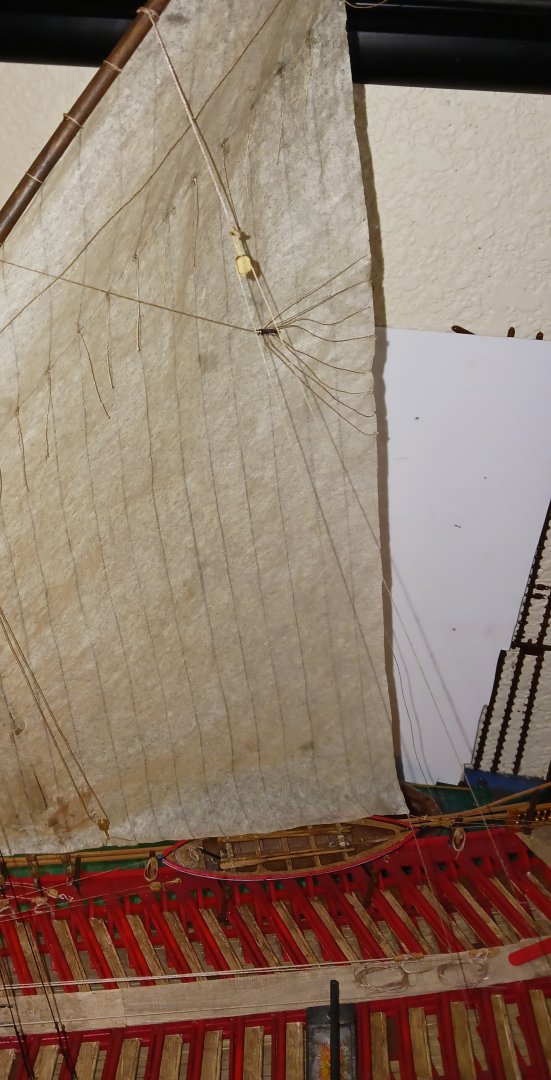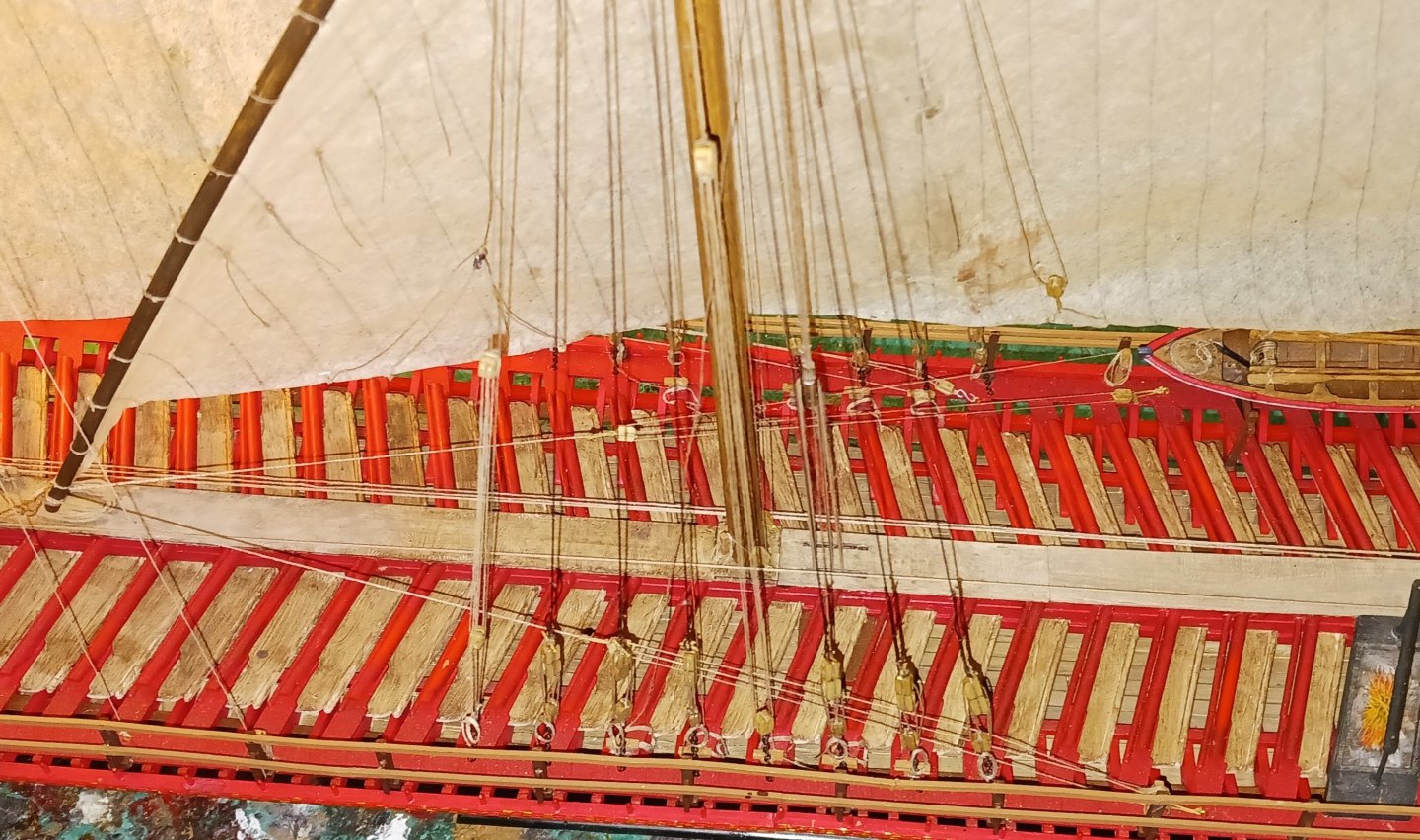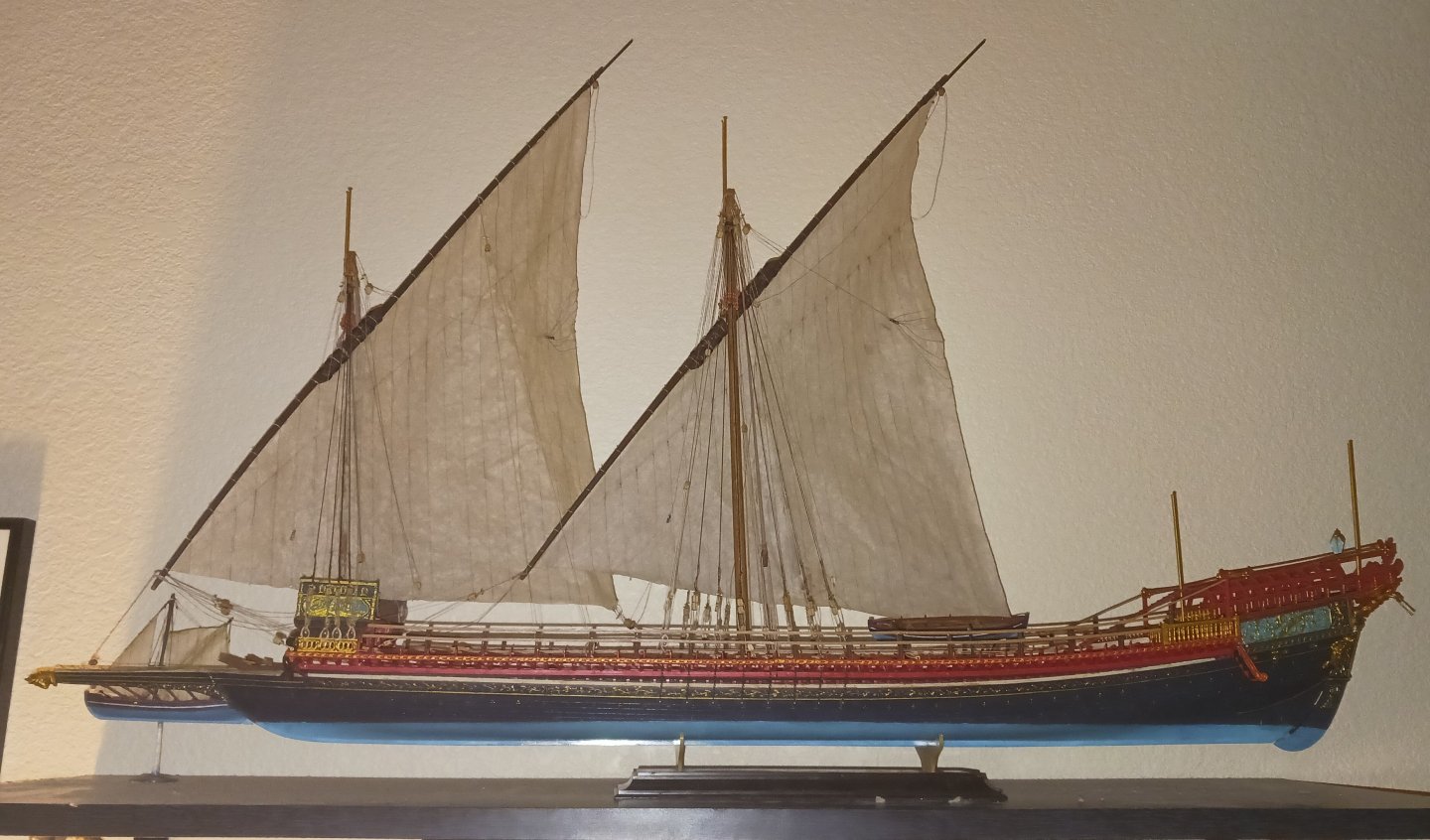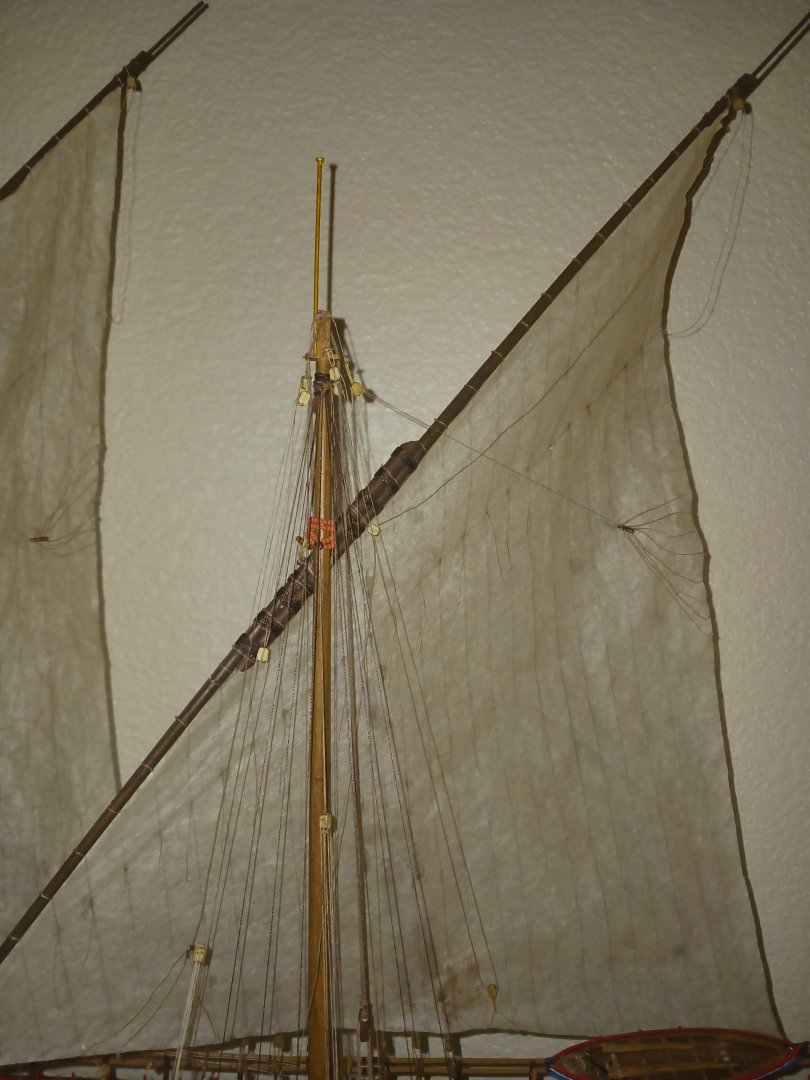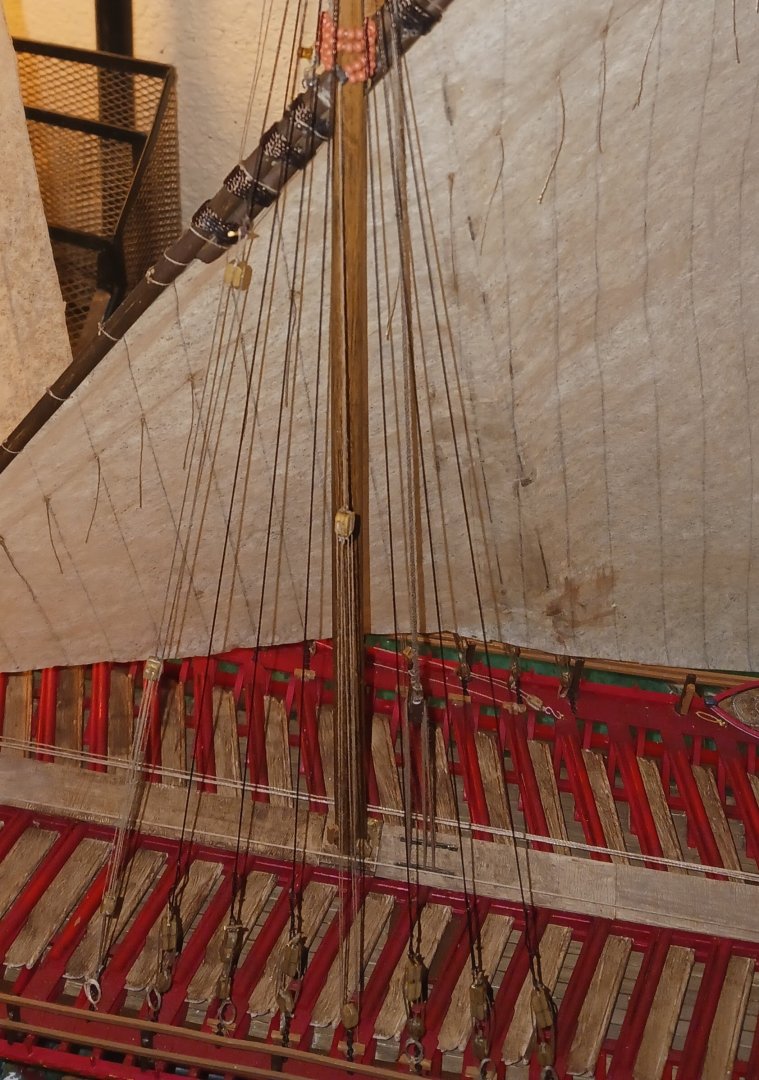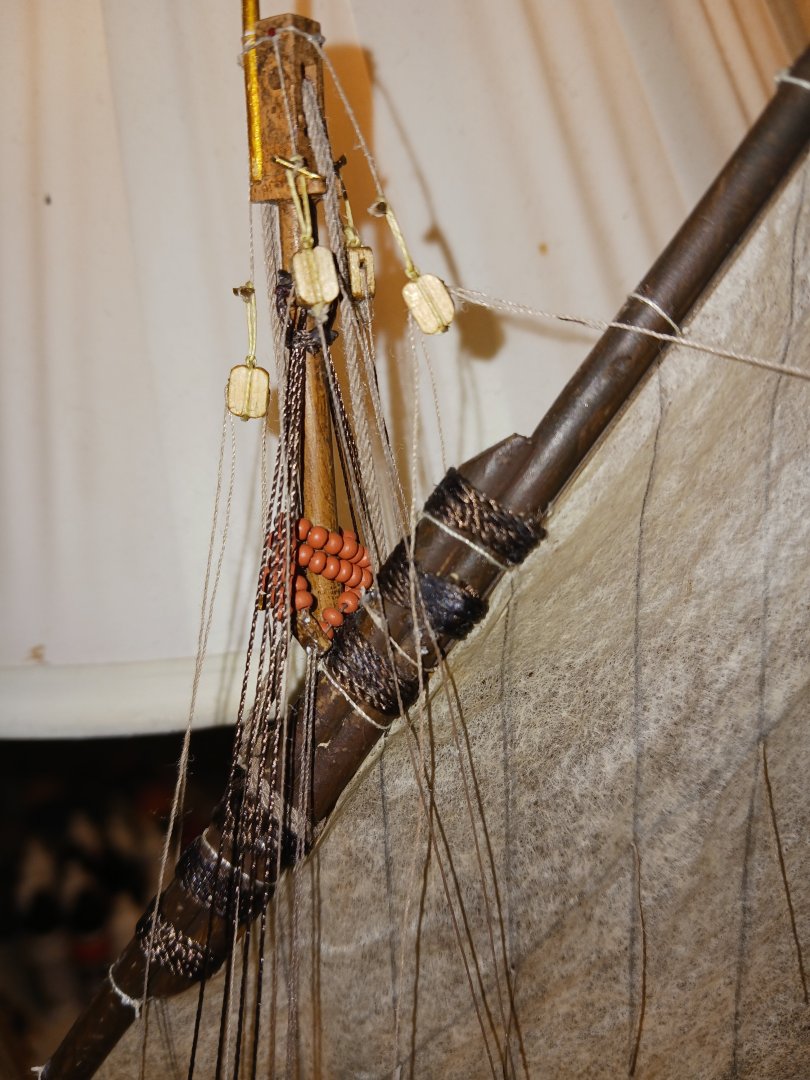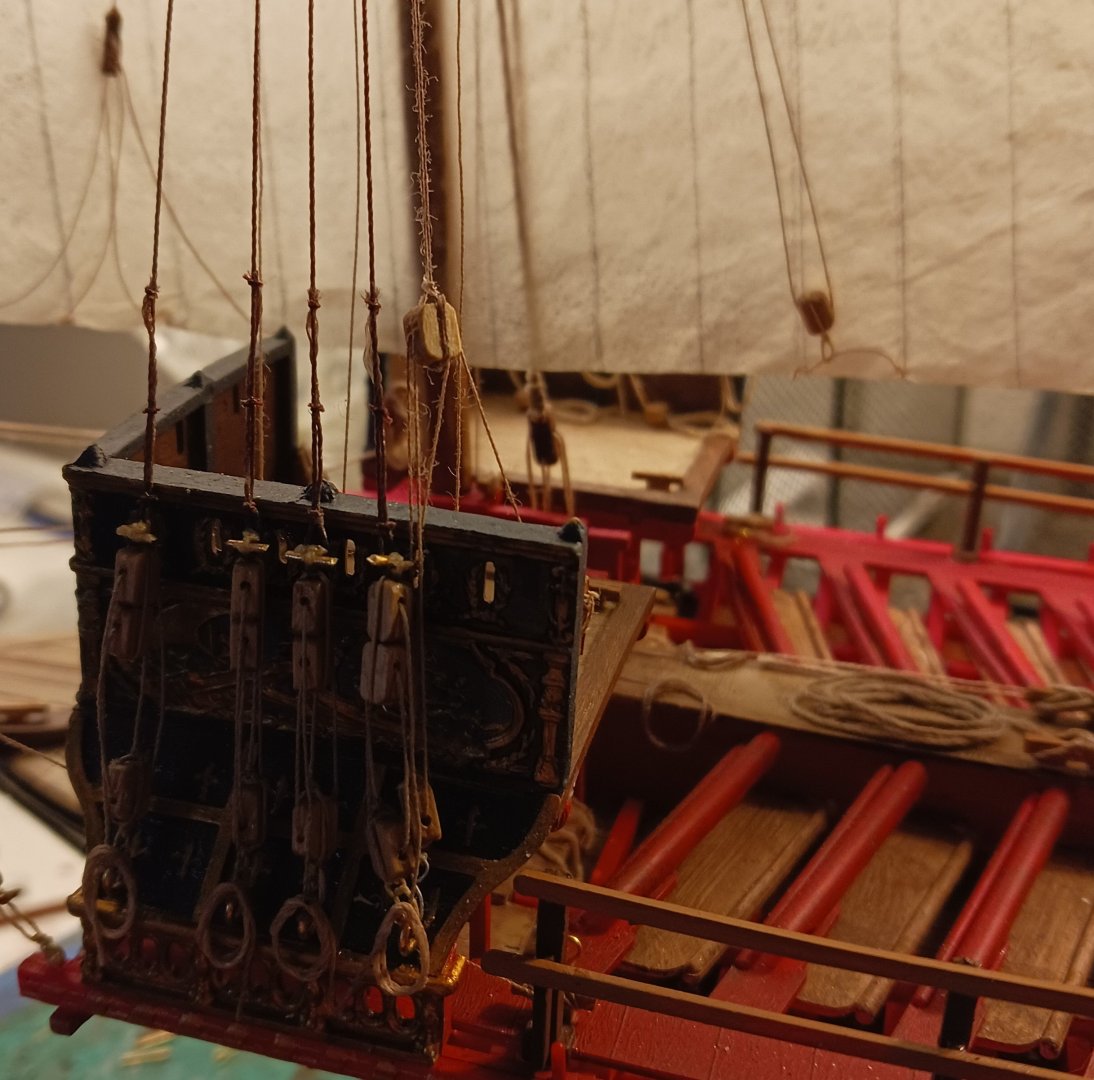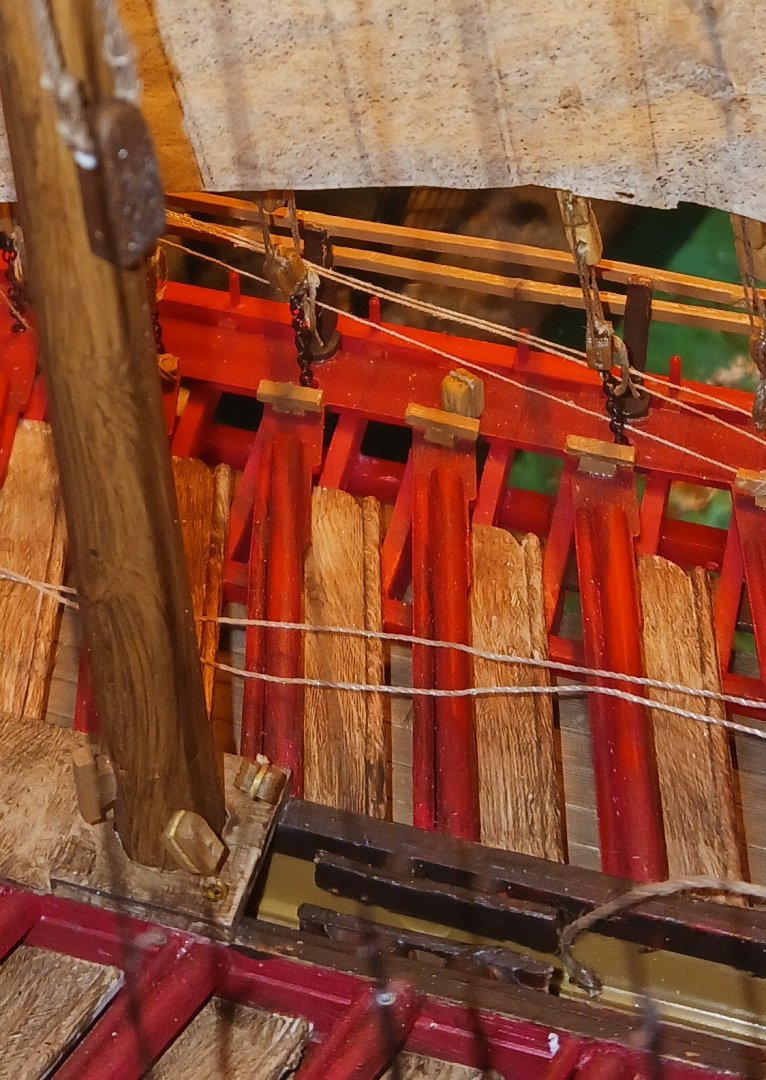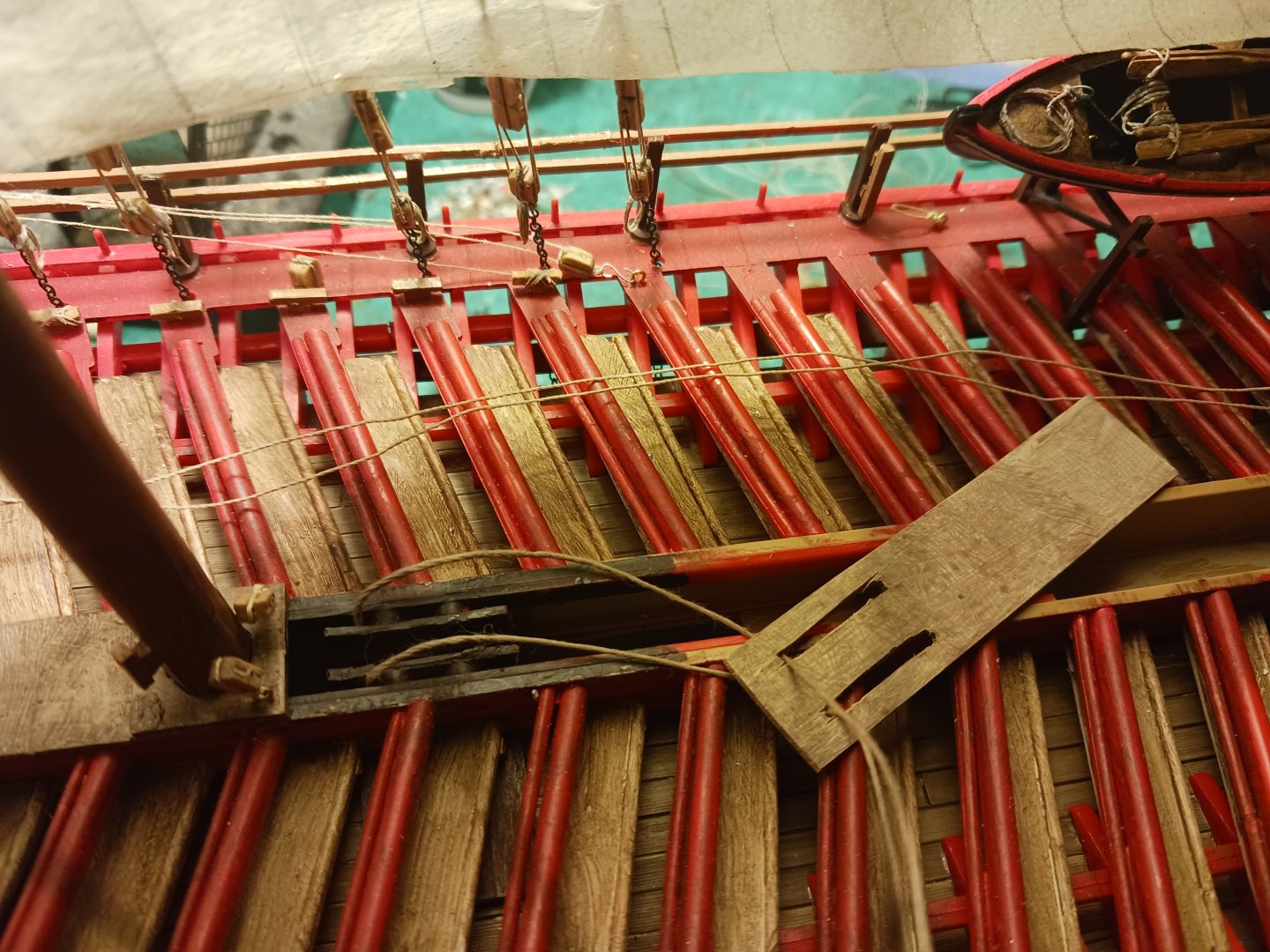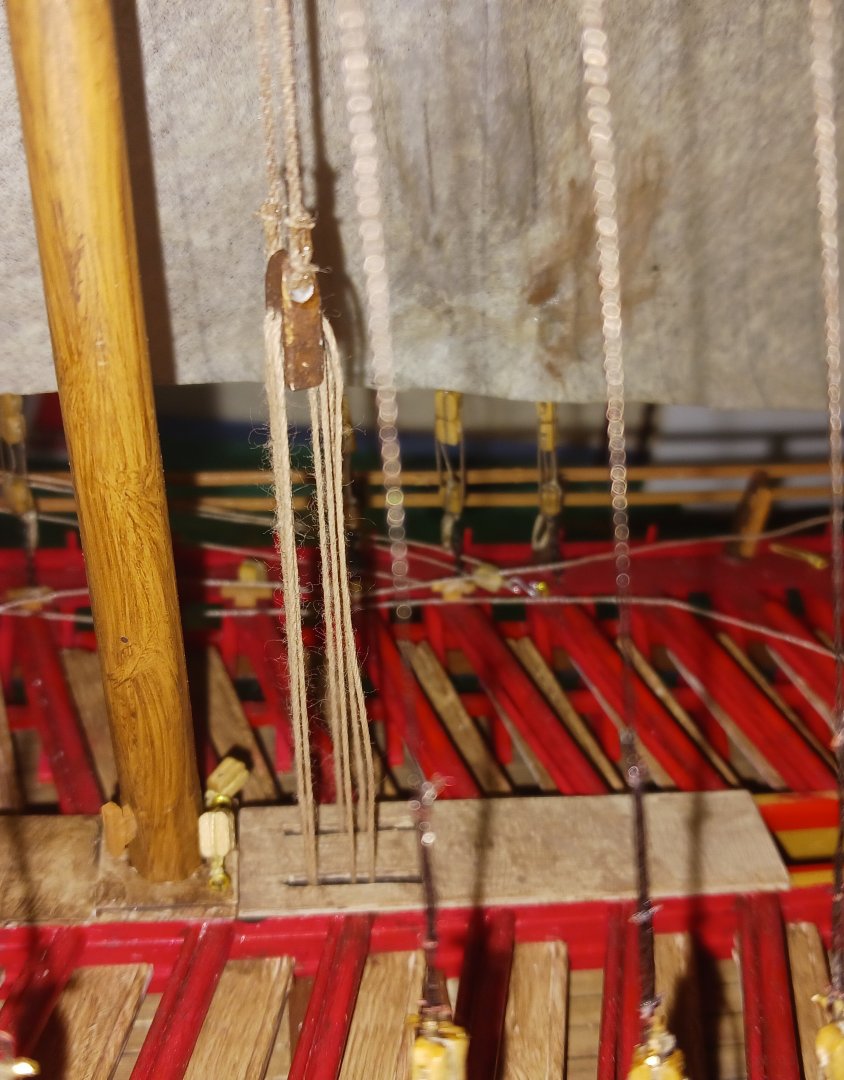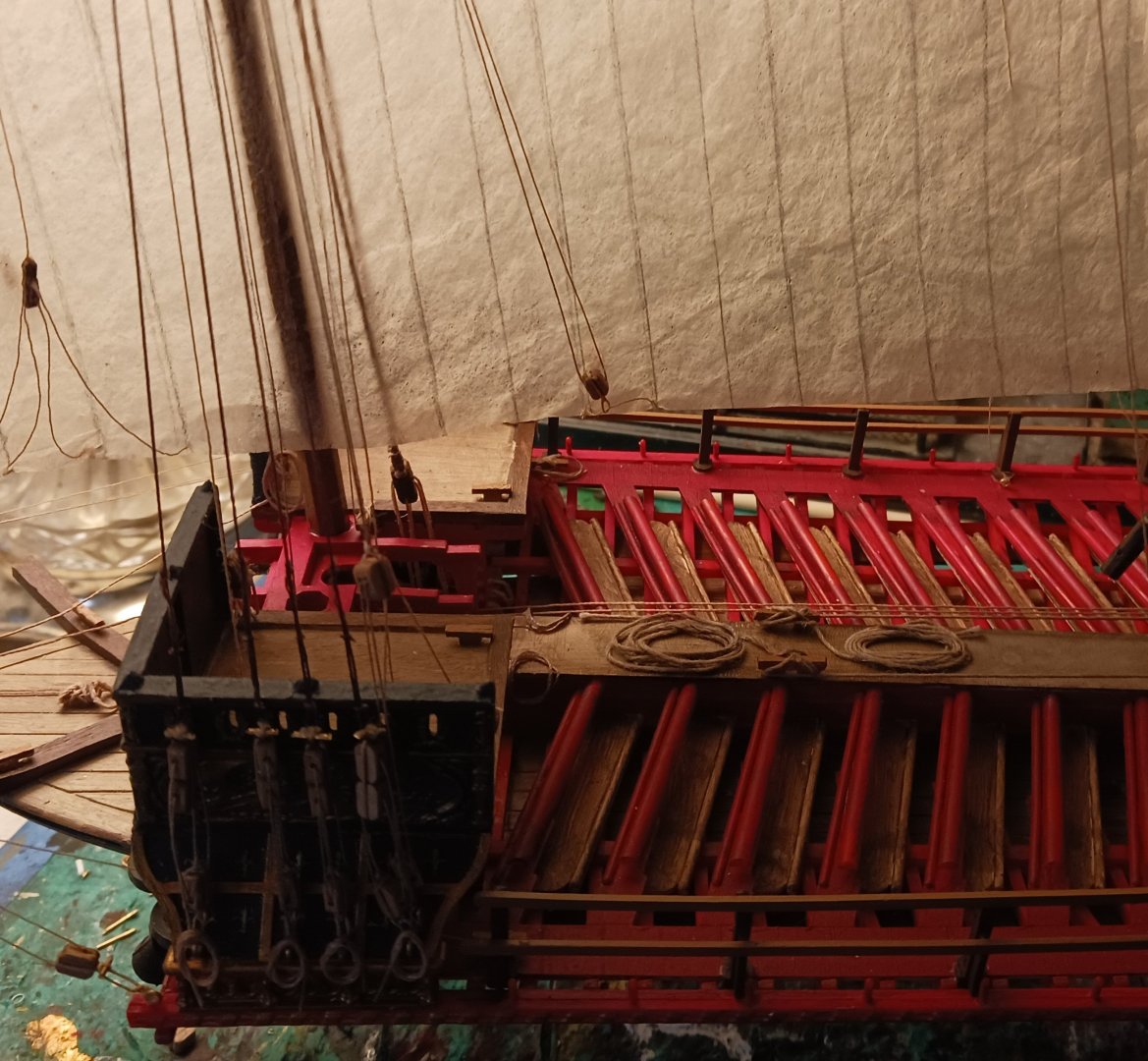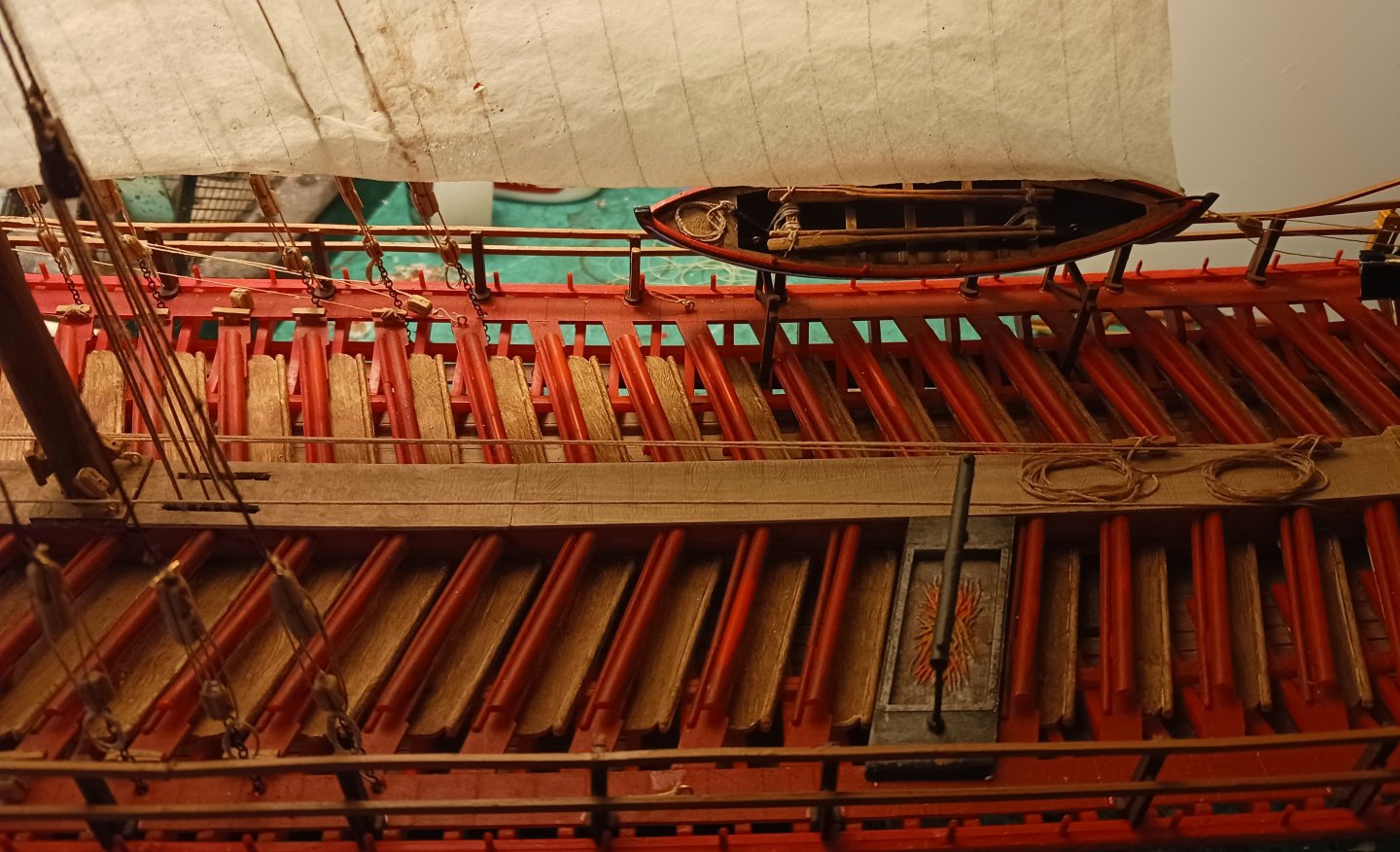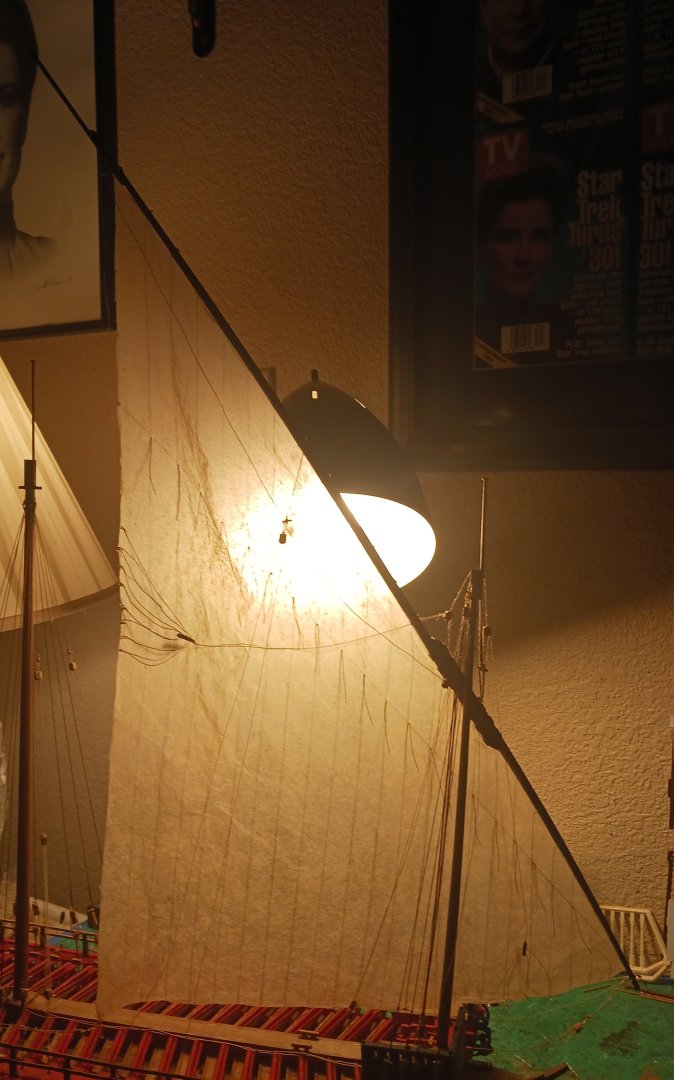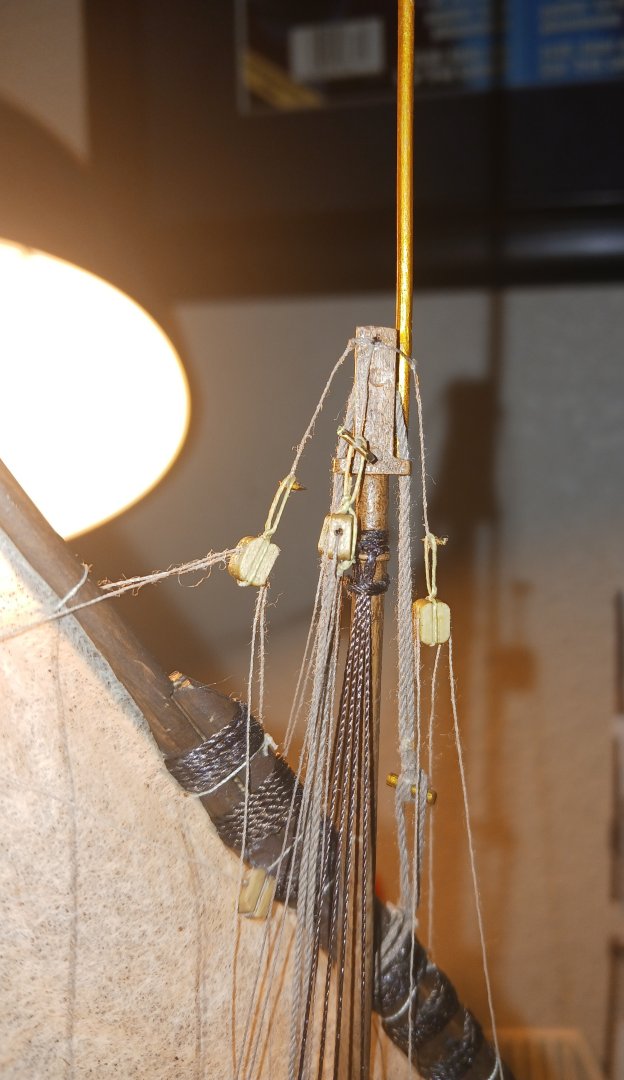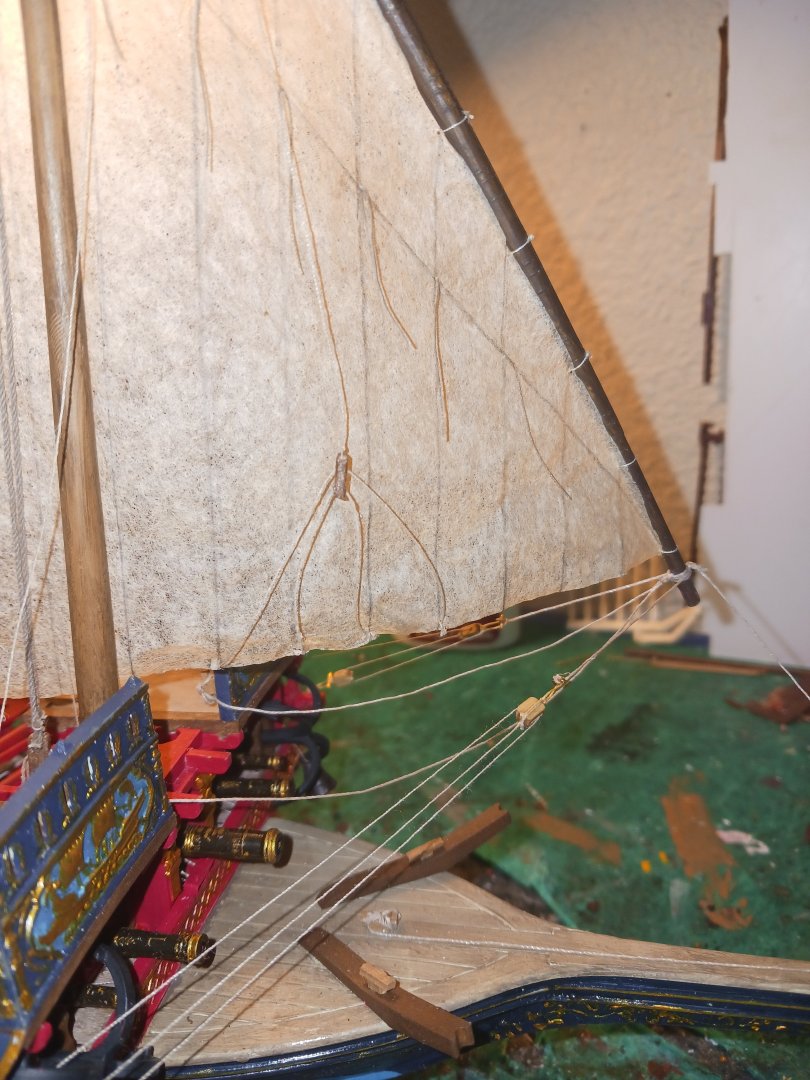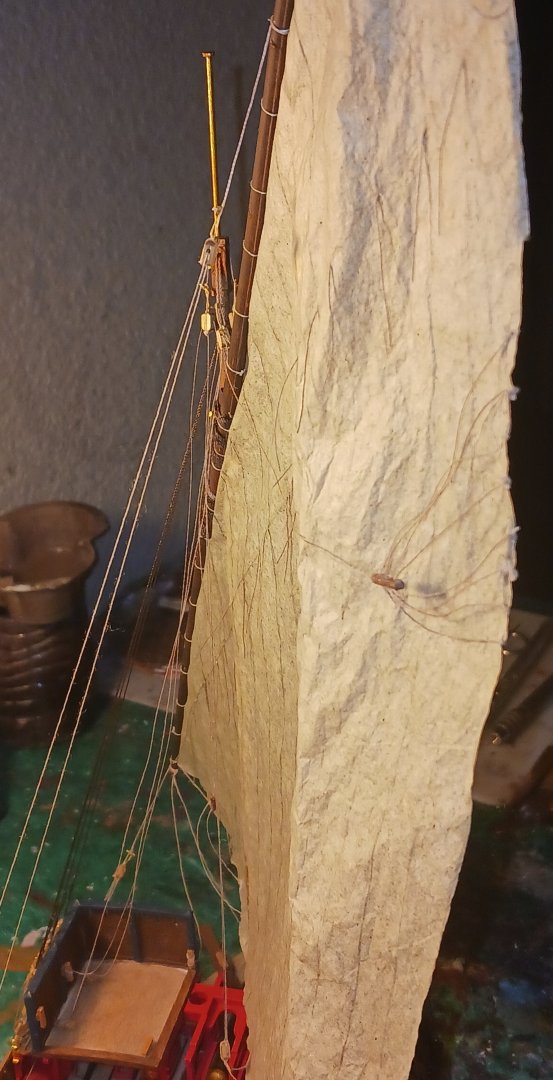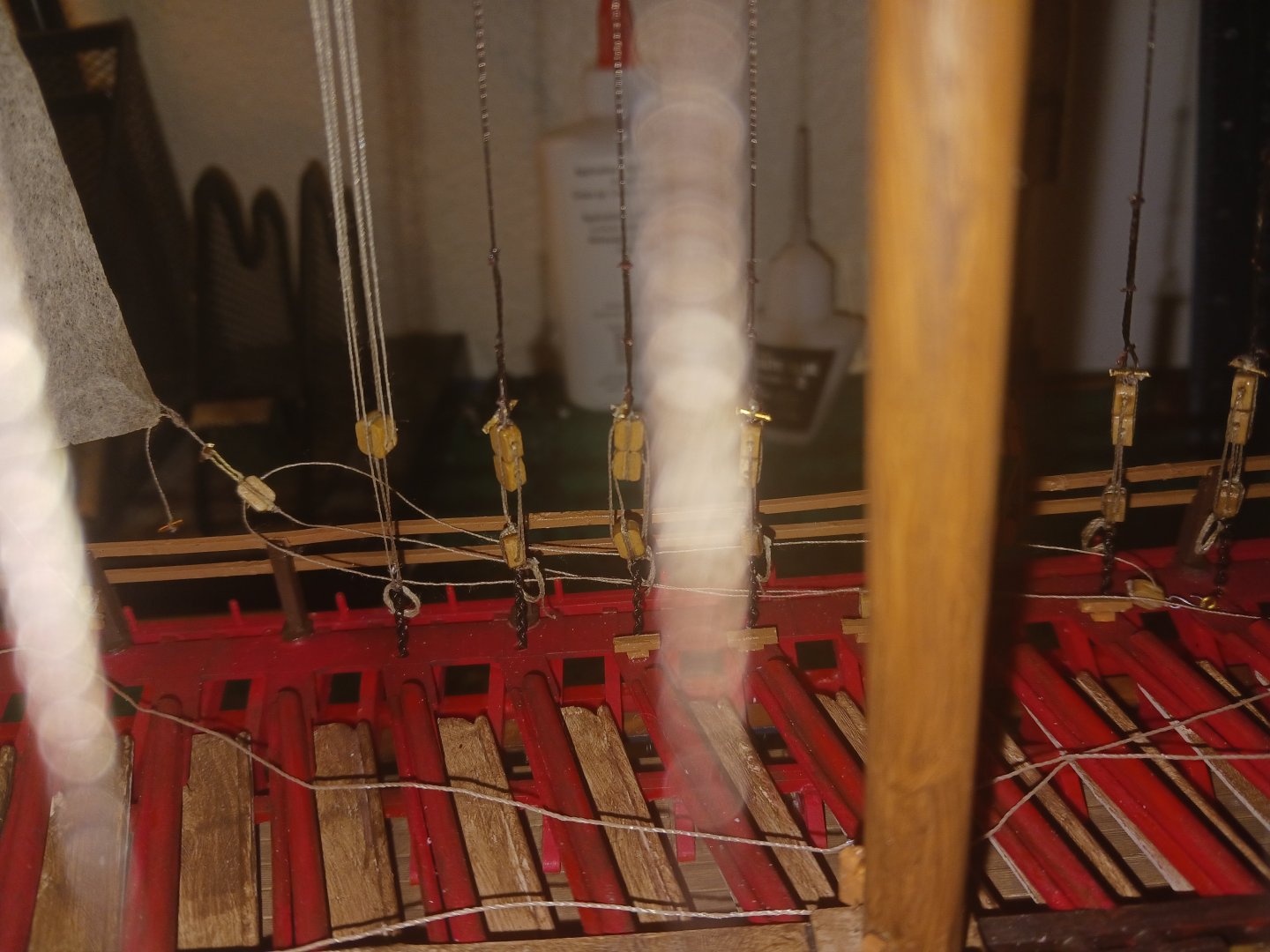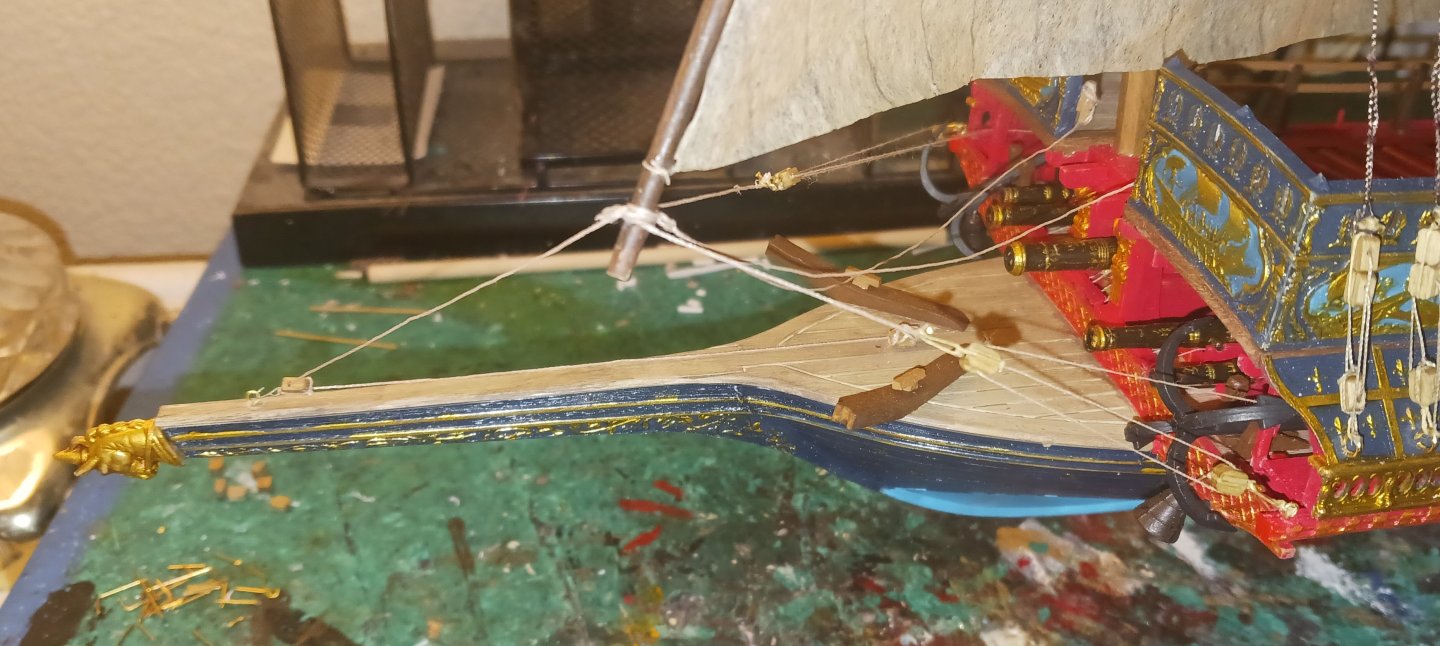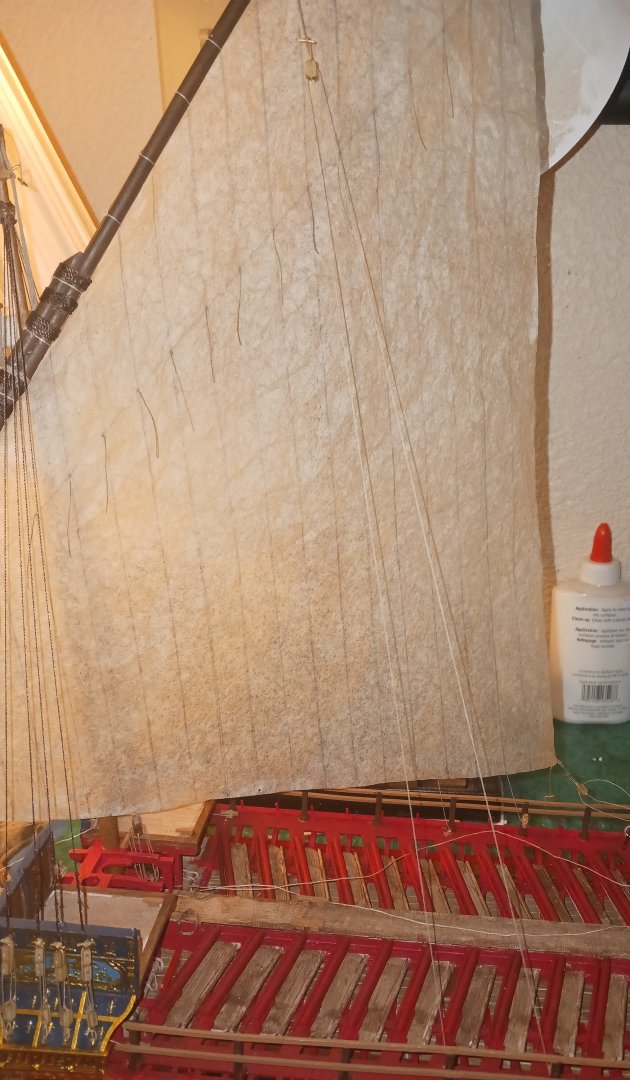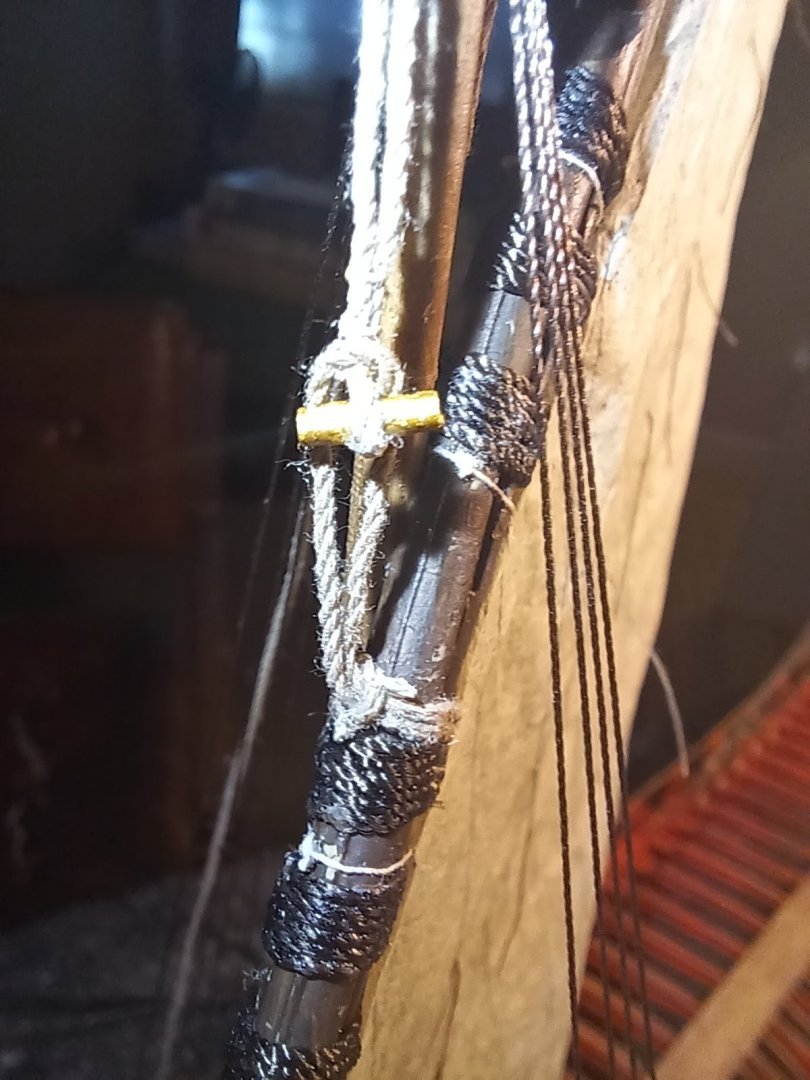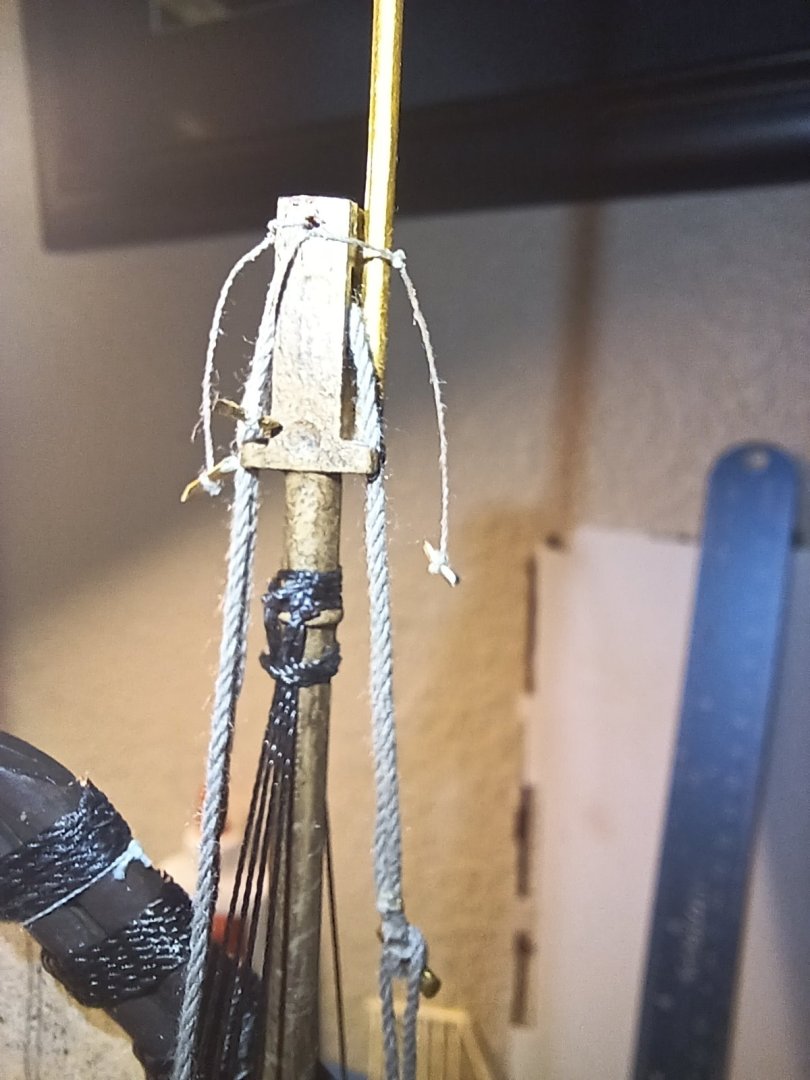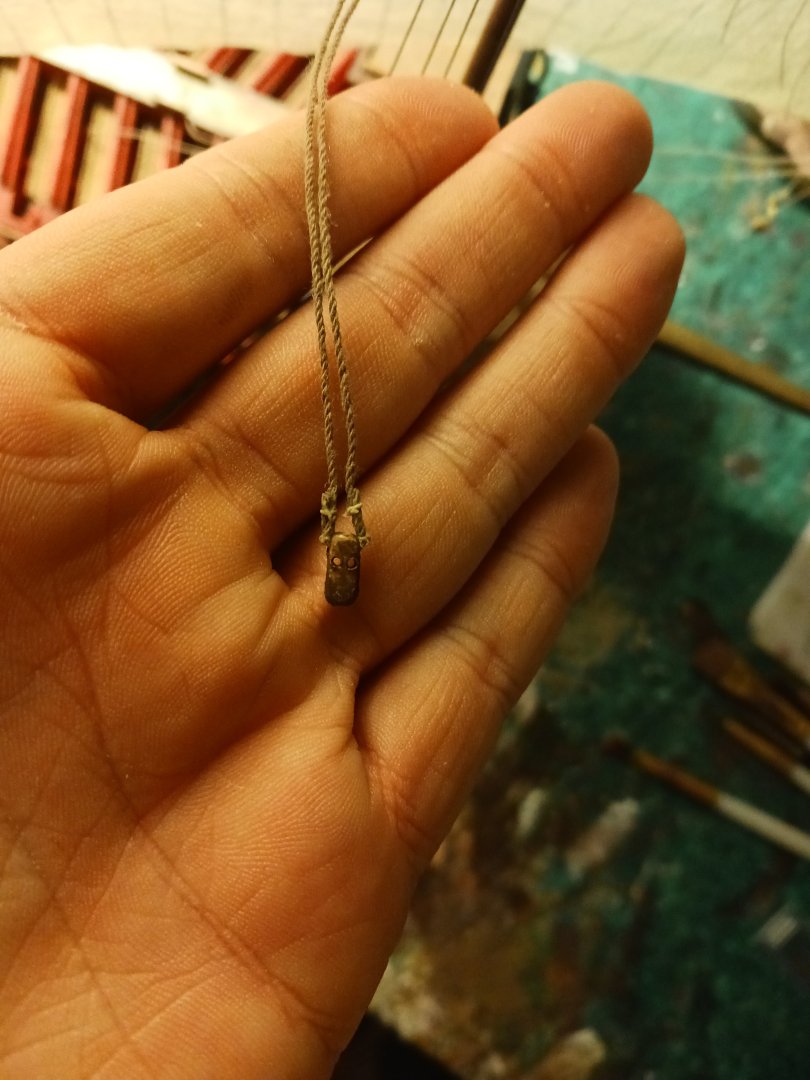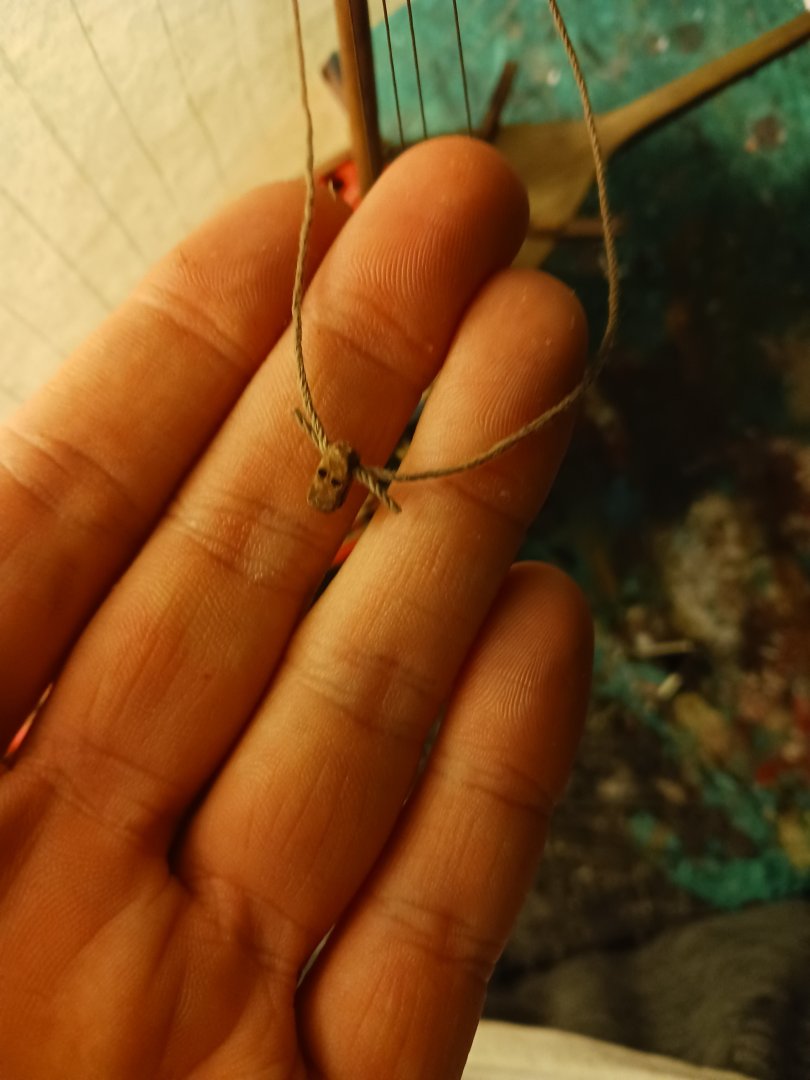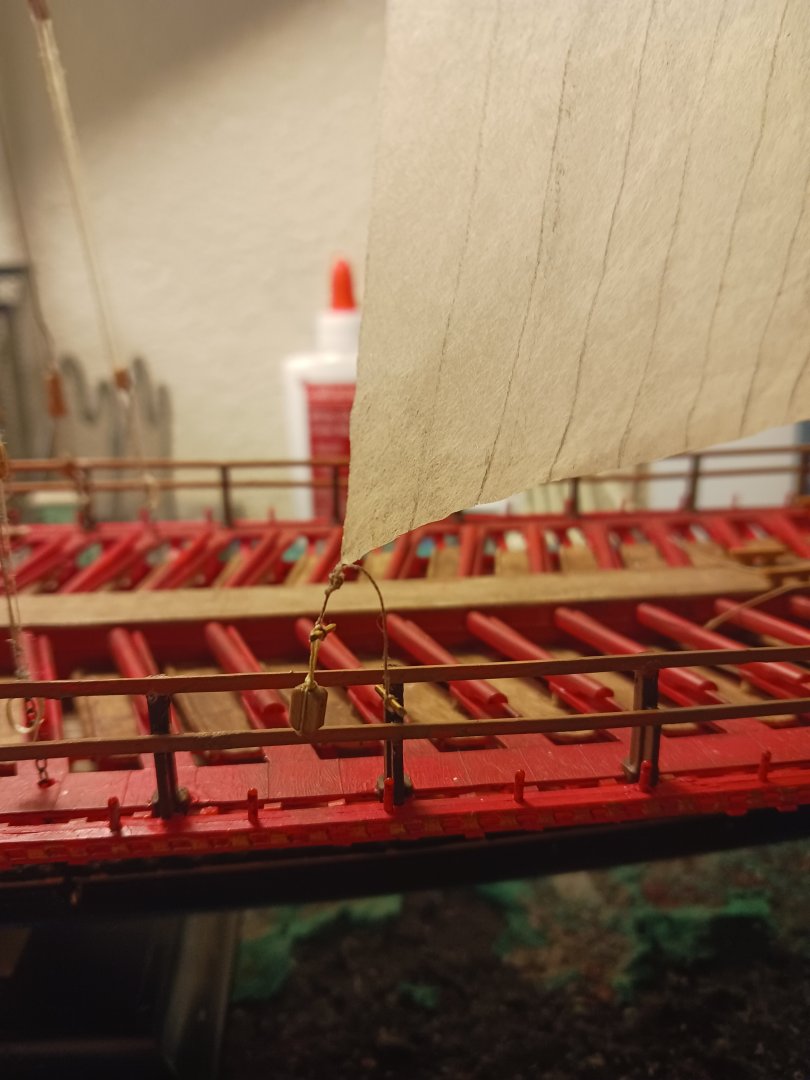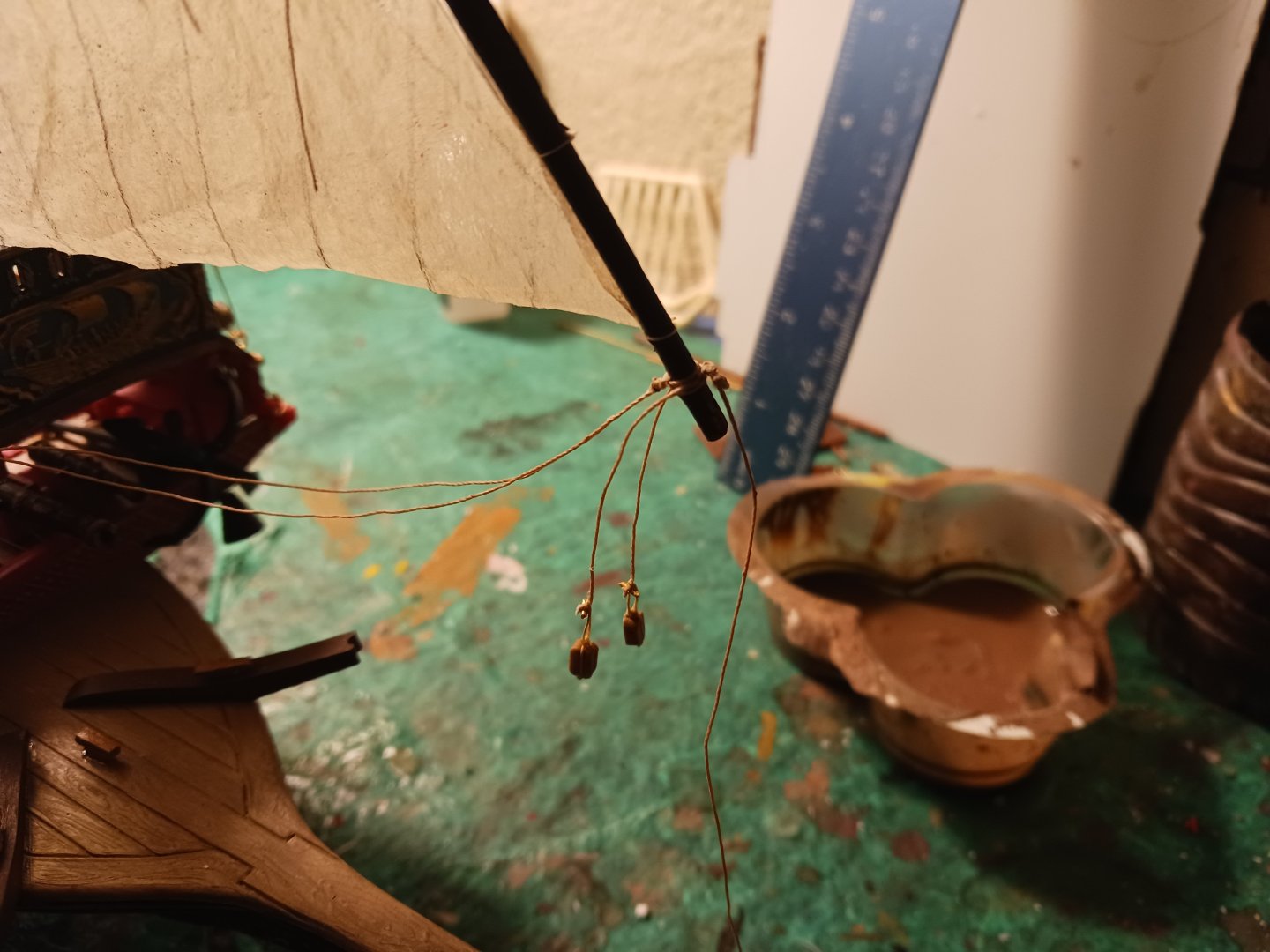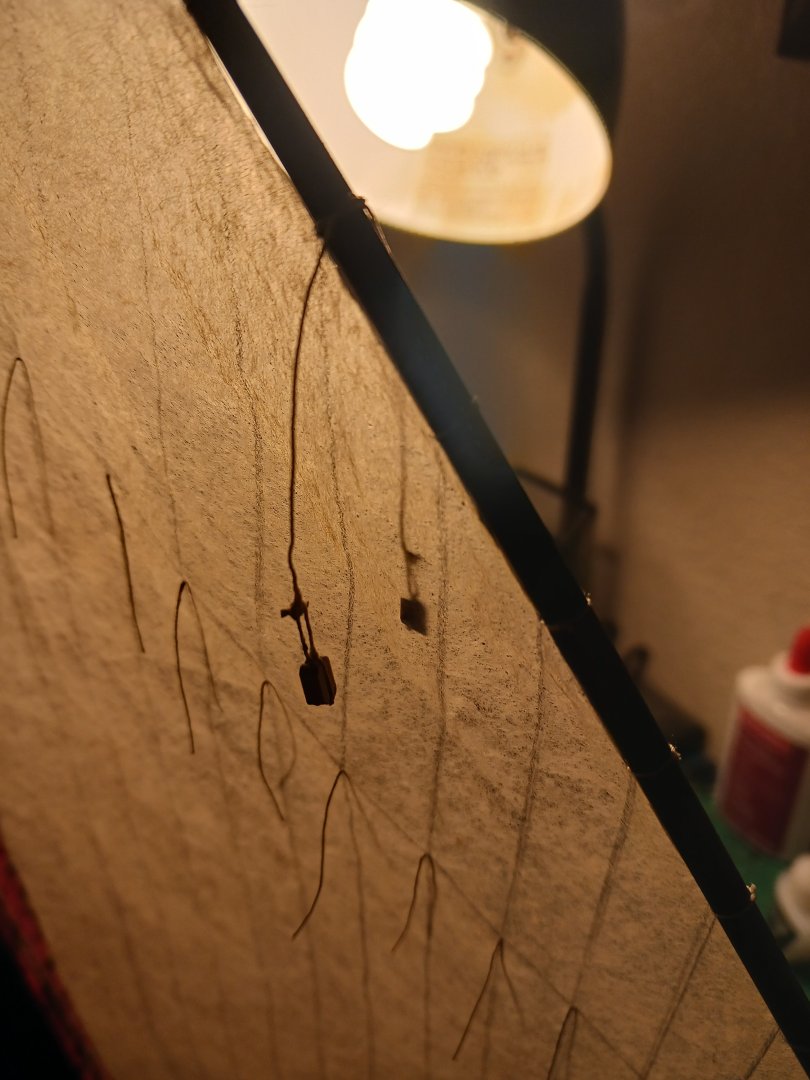-
Posts
1,390 -
Joined
-
Last visited
Content Type
Profiles
Forums
Gallery
Events
Everything posted by Ferrus Manus
-
Yesterday and today, I made the main yard's braces and vangs, and finished the ship's rope coils. Thus ends the rigging phase of the Reale's construction. Both lee vangs are slack, which can't be seen in the photos. The next thing to do is make and mount the "decorative fabrics" of the Reale (the waistcloth, awning, flags, etc) probably starting with the awning.
- 176 replies
-
- la reale de france
- heller
-
(and 2 more)
Tagged with:
-
The final display spot for the Reale, when it is eventually finished, will be right above my work area. I finished both sets of crows feet for the mainsail. I also figured out that if you align paper in a printer just right, and put the images in the center of a Google doc, you can print two-sided flags on one sheet of paper. This only works for flags that are bilaterally symmetrical on the left-right axis. I also tried printing flags on multiple types of silkspan, and this worked better. The first flag is the royal standard of the King of France, and the other three are the Royal Galley Corps standard. Other than that, digital galley-specific flags are ridiculously hard to find. I couldn't find a pennant version of the galley standard, nor could I find the actual flag of the Reale herself. I think the Heller-supplied flags are pretty much worthless and would detract from an otherwise not terrible model.
- 176 replies
-
- la reale de france
- heller
-
(and 2 more)
Tagged with:
-
- 176 replies
-
- la reale de france
- heller
-
(and 2 more)
Tagged with:
-
I figured I would start my research here, on MSW. I am currently a college student studying history, and I plan to focus those studies into nautical archaeology. Does anyone here know of any good nautical archaeology internship programs in the United States? If so, what are the best ones? Any information would be helpful. @ccoyle I might have put this topic in the wrong section.
-
The fore parrels and associated tackles: How I set up the fore and main halyards and associated gear: many modelers forget to add a realistic amount of line in their rope coils. In reality, these ships would have been a mess of rigging on deck.
- 176 replies
-
- la reale de france
- heller
-
(and 2 more)
Tagged with:
-
Another issue I would like to address right now instead of later is the oars. Multicolored oars are relatively rare in Reale models (and galley models in general). I could either paint them blue, white, red or any kind of wood color in their entirety. I will likely end up going with what's shown in the painting, which is dark blue oars in their entirety.
- 176 replies
-
- la reale de france
- heller
-
(and 2 more)
Tagged with:
-
I also found a display spot right above the work area on a shelf. That means the ship will be looked at from the bottom up, which will expose some of the exquisite detail work to the eye, and hide some of the uglier deck details and the railings assuming I put waistcloth on. This also means I might be able to put an awning on the back of the ship without obscuring the gold supports and frame timbers.
- 176 replies
-
- la reale de france
- heller
-
(and 2 more)
Tagged with:
-
Hello boys, I'M BAAAAACKK!!! I apologize for taking almost 2 months off of this project. I decided to work on two off-forum small projects during that time, a small tugboat and a tiny oyster lugger. Anyways, yesterday I managed to get the mainsail penciled in, cut out and riddled with the holes it will need for rigging, and bent to the main yard. I glued the yard to the mast and temporarily rigged part of the main lift. I temporarily put the ship's smaller boat onto the boat gallows so I could see how the boat and the sail interact. The boat ever so slightly fouls the sail, but I wanted the main yard to sit lower on the mast because otherwise it looked too high up off the deck. I probably won't rig the halyard until the reef points, blocks, and some other stuff is put in.
- 176 replies
-
- la reale de france
- heller
-
(and 2 more)
Tagged with:
-
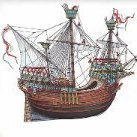
Naval History On This Day, Any Nation
Ferrus Manus replied to Kevin's topic in Nautical/Naval History
I know I'm a day late to post this, but... On November 10th, 1975, the ore freighter Edmund Fitzgerald was lost with all hands in a freak storm on Lake Superior. The sinking of the Edmund Fitzgerald was forever memorialized in Gordon Lightfoot's famous ballad. -
Representations are just that- representations. The representations of the Lomellina ship I have seen have all been wildly inaccurate. I was not claiming swivel guns were found. Neither article I read mentioned swivel guns. I was coming at it from a perspective of assuming the carrack was used as a warship (see the gunports) and might have had the gunwale built to accommodate anti-personnel pieces. I am aware that a Tumblr post (as well as any news report) is likely to be wrong in many significant ways. It is likely that both are true- the ship likely had her own armament, and was carrying large-wheeled land guns for use in the latter stages of the Italian Wars.
-

Remains of 500 year-old shipwreck: Dated 2019
Ferrus Manus replied to Allegheny's topic in Nautical/Naval History
Do we know what type of ship it is? It looks to me like it could be some kind of cross between a carrack and a cog. -
I say she needs a bonaventure. This article mentions a total length of 46.12 meters, or 151.31 feet. https://www.tandfonline.com/doi/full/10.1080/10572414.2023.2186748#d1e587 The Santa Catarina do Monte Sinai was 38 meters, or 124.67 feet. The Mary Rose (or what we know of her length) as per World History Encyclopedia, was 38 meters or 105 feet. These are two vessels smaller than Lomellina, both with bonaventures.
-
I think the gunwale should be made as if it was actually of intended use, as the Lomellina was discovered with guns. I am not aware as to the details of where those guns would have been situated, or if swivel guns were found. I based the Elisabetta's two guns on those found with the Lomellina wreck. That would mean a gunwale (with no clinker planking extending inwards, as is seen on some other carracks) that reaches about upper chest height, assuming the swivel pieces are positioned directly on the gunwale. The Beat to Quarters Tumblr article mentions 15 wrought iron composite guns found on board the ship as cargo. The article does not mention Lomellina being armed herself, but she had gunports. I don't know if you should trust this article though, because it mentions the Lomellina being a cross between a galley and a carrack. https://ltwilliammowett.tumblr.com/post/665321756962308096/the-lomellina-wreck This article, which is more reputable, mentions ten iron guns and two bronze, but no swivel pieces. https://shiplib.org/index.php/shipwrecks/mediterranean-shipwrecks-2/western-mediterranean/lomelina-1615/
-
I like the look of it as well! If you were to go for an accurate look, the ship would need to be painted in its entirety. You should look for primary sources as well as the replica if you intend to do this. As for the rigging, I tend to rig square-rigged vessels starting from the centerline and moving outward. There are plenty of rigging diagrams on MSW for the Bounty. Another source I have that might be helpful to you is "The Anatomy of Nelson's Ships" by C. Nepean Longridge, a book explaining the construction of 18th century British square-rigged naval ships.
- 32 replies
-
- Bounty
- Constructo
-
(and 1 more)
Tagged with:
-
Another issue: the painting I have largely based my decisions off of does not depict the ship with swivel guns, and neither do the diagrams in the Landstrom book. For this reason, I will instead be covering the railings with waistcloth. This should in theory make the railings less offensive to look at. The waistcloth will be a simple strip of red-painted silkspan, nothing fancy.
- 176 replies
-
- la reale de france
- heller
-
(and 2 more)
Tagged with:
-
Sorry for the delay in posting a reply. This is the current progress on the foresail, over the past week: I got the sheet belayed, the two pairs of martnets and buntlines in and belayed, and the reef tackle done. Up next is the clew line (and the main top toggles as a whole), the parrel lines/tackles, and a bunch of rope coils.
- 176 replies
-
- la reale de france
- heller
-
(and 2 more)
Tagged with:
-
I have gotten the fore lift mostly rigged, the lower lines all belayed, the vangs belayed, and the sheet started.
- 176 replies
-
- la reale de france
- heller
-
(and 2 more)
Tagged with:
-
- 176 replies
-
- la reale de france
- heller
-
(and 2 more)
Tagged with:
About us
Modelshipworld - Advancing Ship Modeling through Research
SSL Secured
Your security is important for us so this Website is SSL-Secured
NRG Mailing Address
Nautical Research Guild
237 South Lincoln Street
Westmont IL, 60559-1917
Model Ship World ® and the MSW logo are Registered Trademarks, and belong to the Nautical Research Guild (United States Patent and Trademark Office: No. 6,929,264 & No. 6,929,274, registered Dec. 20, 2022)
Helpful Links
About the NRG
If you enjoy building ship models that are historically accurate as well as beautiful, then The Nautical Research Guild (NRG) is just right for you.
The Guild is a non-profit educational organization whose mission is to “Advance Ship Modeling Through Research”. We provide support to our members in their efforts to raise the quality of their model ships.
The Nautical Research Guild has published our world-renowned quarterly magazine, The Nautical Research Journal, since 1955. The pages of the Journal are full of articles by accomplished ship modelers who show you how they create those exquisite details on their models, and by maritime historians who show you the correct details to build. The Journal is available in both print and digital editions. Go to the NRG web site (www.thenrg.org) to download a complimentary digital copy of the Journal. The NRG also publishes plan sets, books and compilations of back issues of the Journal and the former Ships in Scale and Model Ship Builder magazines.


